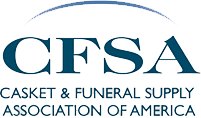At the CFSA headquarters office, we frequently receive questions from the public regarding caskets, funeral supplies, and the overall industry. A few months ago we received an intriguing question from an author who was doing some research for a fictional book he was writing: “Is there normally some sort of logo, engraving, or other form of marking that would be somewhere on the casket? If so, where would it be, and what would it look like?” For the answer, we turned to former CFSA Board member Mike Beardsley of Thacker Caskets, who previously worked for Marsellus Casket Company for decades. Mike’s historical insight in answering this question was so valuable that we are printing an edited version below. Thank you, Mike Beardsley!
Great question! The answer really hinges on what time period you are researching. Up to roughly the 1920’s, caskets were rarely marked as to their makers. Identifying caskets from the 1850’s through the 1920’s is very difficult. Very few casket designs were patented. As a result, most firms copied the popular designs of their competitors. During the formative days of casket manufacturing, the great majority of casket companies were regional and fairly small. They served a few cities or perhaps several counties. These small companies probably didn’t see a need to label their products since “everyone knew them.”
As mentioned, identifying unmarked caskets from this era is really tough. Yes, there were a few manufacturers that produced caskets so unusual that they basically identify themselves…the Owego Cruciform Casket Company, the Crane & Breed cast iron mummiform coffins, Belleville Electric Caskets, DeCamp Glass Casket Company, etc. But, you could count these firms on 1 to 2 hands.
As some casket companies grew larger and developed multi-state territories (and even a few went nationwide) they felt the need to label their products. Beginning in about the 1920’s, casket manufacturers usually affixed labels or decals to the foot ends of their caskets…most chose the center of the base rail (see the Marsellus photo and National Seamless Copper ad below, top and bottom left). Merit Casket and some others chose to put their label on the top ledge at the foot end (see photo below, bottom right).


Finally, some casket companies offered “warranties” in the 50’s, 60’s, etc. These were basically not worth the paper they were written on. Many families sneered at them, and they often ended up under the mattress and buried with the casket. So, in a really left-handed way, they could be used for ID down the road.
While working on this question I came across a small brochure that Marsellus printed in December, 1925. The title was, “Shall caskets be labeled?” In the brochure, it states that the NFDA House of Delegates voted at the 44th Convention in West Baden, Indiana, on October 8, 1925, that the Executive Secretary should contact every state association and speak with them about casket labeling. Apparently, the National Selected Morticians (NSM) group took the same course. They talked about mandatory labeling of caskets as to their maker and the construction material. The stated purpose was that this ruling would “go a long way toward eliminating the practice of casket substitution.” Marsellus went on to state that it has been labeling their caskets “for many years” in advance of this anticipated ruling.
I hope that this is helpful!
Editor’s note: Mike Beardsley also chaired CFSA’s 100th Anniversary committee in 2013, and led the research behind our commemorative book, “100 Years of Service.” The book is a glorious celebration of the casket manufacturing industry, with over 100 rare, vintage photographs dating to the 1800’s. Limited quantities are still available to purchase from CFSA one our website (go to Resources > CFSA Store) or by calling the headquarters office. The price is $29/book, with bulk discounts available.

